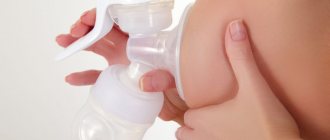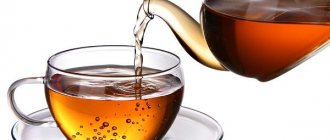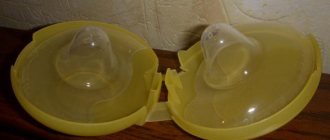How to choose the right time to stop lactation
In order to understand how to stop breast milk lactation correctly, you must first understand what stages lactation goes through from the beginning of breastfeeding to complete cessation.
Stages of breast milk production
- Preparing the mammary gland for feeding during pregnancy.
- The beginning of the lactation period is the baby's first attachment to the breast and the production of the first colostrum.
- The transitional stage is the transformation of colostrum into mature milk; during this period, “hot flashes” often occur, which are characterized by an increase in temperature and discomfort in the chest.
- Established lactation is the main period of breastfeeding, during which there may be several crises when the amount of milk decreases for a certain period of time. At this stage, the first complementary foods are introduced during breastfeeding.
- Involution of the lactation period is a reduction in the mammary gland and a gradual decrease in breast milk production.
It is the last stage that is the optimal moment to stop breastfeeding, because during this period, transferring the child to another type of food occurs most painlessly.
Signs of lactation involution:
- Constant feeling of physical fatigue after each baby's latching. The woman notes weakness, which is more likely characteristic of the postpartum period.
- Deterioration in general health. These manifestations are different for each woman. Some note dry skin and hair loss, others note problems with teeth and chronic colds. It is also possible to experience increased sensitivity of the nipples, even painful sensations, from which even breast pads do not help.
- The baby begins to suckle more actively, he literally hangs on his mother for days, which exhausts both himself and her.
- Chronologically, involution occurs no earlier than the child is fourteen months old. This is characterized by stable and complete lactation. If a woman had problems with feeding initially, then manifestations are possible at an earlier age.
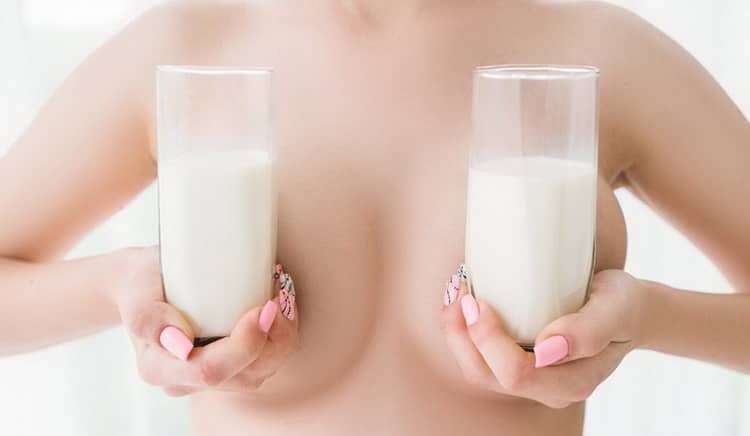
In what cases is it necessary to suppress lactation?
The need to suppress lactation arises when circumstances develop that prevent the child from drinking milk, for example, due to a woman’s illness, her taking medications, or due to personal circumstances.
Among the main reasons:
- The need to go to work full time;
- The mother is sick with active tuberculosis or is being treated for it - she can infect the child, and drugs that pass into breast milk can inactivate the BCG vaccine administered in the maternity hospital;
- HIV, alcoholism, drug addiction in the mother - threatens to infect or intoxicate the child;
- Taking antiepileptic drugs, chemotherapy, using iodine preparations (substances can penetrate into milk and have a toxic effect on the child’s body);
- A detected allergy to lactose in a child - any milk is contraindicated;
- Sepsis in the mother - an obstacle will be both the serious condition of the woman and the strong antibiotics prescribed for treatment.
Lactation for more than 1.5-2 years is detrimental to a woman’s health (the quality of bones and teeth deteriorates, hormonal imbalances occur, etc.), so the child’s age exceeding this period is a physiological reason for stopping feeding.
Natural ways
Medications are not always preferable, because any medicine can cause side effects. Let's first figure out how to stop lactation without pills.
Feed reduction method
The essence of this method is to gradually reduce the number of feedings until the need for them disappears altogether. First you need to remove one breastfeeding and replace it with something else. After the baby adapts to the new schedule, replace the second, then the third. And behave in this way until the milk disappears from the breast completely.
The breasts, in any case, will still swell, because the body is accustomed to a certain feeding schedule. In this case, you need to express about halfway each time to avoid discomfort. However, milk may still ooze from the nipples and to avoid wet spots on clothing, breast pads should be used.

Over time, the amount of milk will decrease until it reaches zero. This method is the most physiological.
Is it possible to tighten the breasts?
During the time of our ancestors, this method was quite popular. Nowadays, mothers often advise their daughters to wrap their breasts with an elastic bandage. Supposedly this prevents the flow of milk.
The benefits of this method have not been proven , but the expected harm is very great. The fact is that a tight bandage interferes with blood circulation in the tightened area. In addition, a woman does not feel when milk comes in and cannot control the degree of tension in the mammary gland. This can cause congestion and, as a result, provoke mastitis.
The best option in this situation is to choose a thick bra made from natural fabrics, which will act like a corset. This will not only help tighten your breasts somewhat, but will also prevent the formation of stretch marks.
Important! During interruption of lactation, you should not eat spicy or salty foods, as they can provoke thirst. This, in turn, can cause increased milk production.
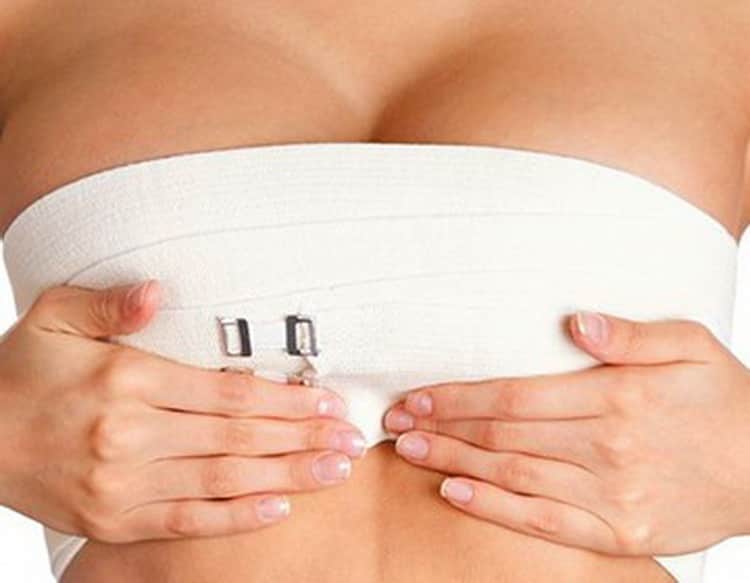
If using an elastic bandage does not bring the desired result, then you can try traditional methods that were popular at any time. Let's figure out how to stop lactation at home using natural remedies.
Folk recipes
There are a number of herbal remedies that have a depressing effect on breast milk production. Most often they have a diuretic effect. However, if the urgent question is how to quickly stop lactation, then folk recipes will not be so effective.
In order to prepare a diuretic infusion, you need to purchase the following herbs: sage, basil, bearberry, parsley, lingonberry. They can be used both together and separately. To prepare the product, you need to take two tablespoons of the herb and add two glasses of boiling water. After the herb has been steamed for two hours, you can begin taking it. You can take the infusion instead of water. The maximum permissible drink is up to six glasses of this liquid per day. You should expect relief from your condition no earlier than after four days. But the flow of milk will gradually decrease, and hardening in the breast will decrease.
In addition to the above folk remedies, you can also use belladonna, jasmine and horsetail. All of them are diuretics, which significantly reduces lactation. All herbs must be taken according to the instructions on the package. However, you should not exceed the dosage.
Peppermint has two beneficial properties: it increases diuresis and also calms the nervous system. You need to add three tablespoons of chopped mint to the thermos and add half a liter of water. You can take the infusion three times a day on an empty stomach.
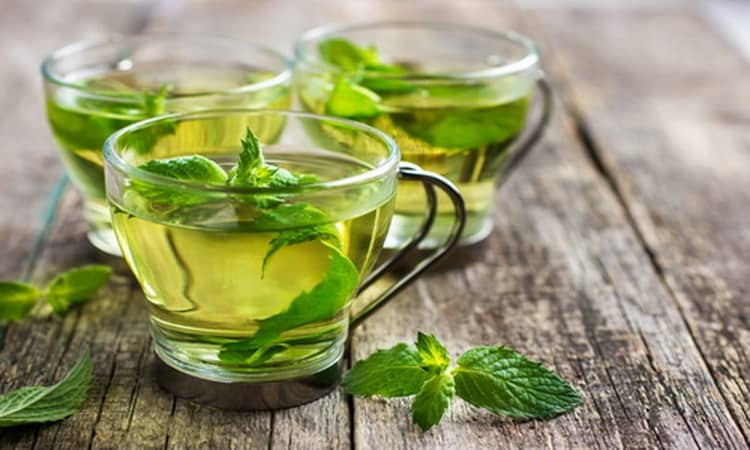
But sage is rightfully considered the queen among herbs that reduce milk production. Despite the spicy taste, its beneficial properties allow you to stop breastfeeding your baby in a matter of days. And, besides, it has a positive effect on a woman’s immunity, which is important when stopping breastfeeding.
Compresses
There is another method, very popular among the female half of the population, about the benefits of which there are still conflicting opinions. The main thing in the matter of self-medication is not to harm your health. Each method should be approached with some criticality and soberly assess the pros and cons of each of them.
Compresses to stop milk production:
- Camphor oil - it must be applied to the entire surface of the mammary gland, with the exception of the nipples. After this, you need to create a warming effect by wrapping the area with a warm scarf or handkerchief. If the discomfort becomes unbearable, then taking anti-inflammatory drugs, for example, Paracetamol, is allowed.

- White cabbage leaves - cooled leaves are applied to the mammary gland and secured with an elastic bandage. Before use, the leaves must be cooled and then mashed until juice appears on their surface. You can keep this compress for about an hour or two, and do it once a day. Usually, complete disappearance of unpleasant symptoms occurs within a week. At least this method does not pose any danger to women's health.
- Ice - this method is suitable only for the most resistant. Proponents of this method suggest taking ice cubes and putting them in a towel or other cloth. The main thing is that it is soft. But keeping such a compress for longer than twenty minutes is not recommended, because it can lead to a cold. However, although a cold compress can relieve unpleasant symptoms during cessation of lactation, its perceived harm may significantly outweigh the expected benefit.
Quit abruptly or wean gradually
There are also two positions: on both sides there are doctors. I quote “it is not recommended to stop feeding abruptly; it is better to do it gradually so that the load on the body and hormonal changes are not too sudden and powerful. In addition, this is also a huge stress for the child, try to mitigate it as much as possible.” I tried to follow this position for six months, consistently trying to feed the child complementary foods and distract him from the breast, giving him water (for my fundamental reasons, he does not know about the nipple), both night and day.
The situation was exactly the opposite: the more often I tried to feed him, the more often he latched onto the breast, whining and crying demanding “more.” At one and a half years old, he suckled more than in a month: there was not enough milk, and the baby tried to replenish the supply of substances with frequent feedings. Then I began to think about another plan (after all, the child did not eat anything - the grandmothers were busy every day): to leave, leaving the baby with the grandmother, as most of us do, judging by the conferences. Fortunately, I didn’t have to resort to this sadistic method! Breast engorgement with a sudden cessation of lactation and the danger of pumping are also scary. And yet I decided - just at that time I was reading about the development of creative potential and flexibility of thinking. We couldn’t find another way online, so our pediatrician’s story about the patch came to mind. My father suggested the pepper idea. When the child once again refused Heinz and Frutolino porridge, buckwheat and Agusha yogurt, I smeared hot pepper on my chest (monster, you exclaim!) and opened access to the body, preparing a glass of water and milk to wash it down. Twice was enough for Mishka - the whole family shouted “Ugh, bitter one,” fueling his craving for theatricality. During the day, the baby broke his knee, I smeared it with iodine and covered it with a band-aid. It’s not hard to guess that we did the same trick with the sick boob. As a result, the baby was busy treating his mother, and not regretting the end of breastfeeding. At night the child sucked two cups of milk, grunted a little in my arms, and the next morning he stood up a different person. The main thing is that I was nearby.
Tablets that stop lactation
There are cases when breast milk production must be stopped not during the period of lactation involution, but at the peak of feeding. This may be due to both the health of the mother and the health of the baby.
In such a situation, the use of traditional methods is not advisable, because it may not give quick results, but only lead to lactostasis, or even mastopathy. Therefore, pills that stop lactation can be an excellent solution. At the moment, there are a huge number of medications of this type. They allow you to stop breastfeeding in a matter of days.

However, there is still heated debate in the gynecological community about the advisability of taking them.
Why you can’t take medications yourself
Tablets that stop lactation mostly contain a hormonal component. Therefore, it is not possible to talk about the absolute safety of taking these funds. It is very likely that in addition to stopping milk production, a woman will receive a whole “bouquet” of side effects.
These drugs have a number of contraindications, which include: diabetes mellitus (especially insulin-dependent), pathologies of the urinary system, chronic inflammation of the kidneys, a state of hypertensive crisis and many other pathologies.
Therefore, the treatment plan can only be written by an experienced doctor, who will select the dosage and regimen for taking a particular drug, eliminating possible negative consequences.
List of popular drugs
At the moment, there are a number of drugs that gynecologists prescribe to stop the production of breast milk. The composition of these medications is different, as is the dosage allowed for use. The treatment regimen is selected based on the individual situation, as well as the stage at which the lactation process is located.
Drugs that stop lactation: Urozhestan, Bromkreptin, Cabergoline, Orgametril, Bromcamphor, Norkolut, Dostinex, Acetomepregnol.

The above are just some of the products with a milk-stopping effect. Their list is actually much longer. However, it is not possible to present it in an information article, because their use is permissible only after consultation with an experienced doctor, who will choose the necessary drug.
Depending on which drug was chosen, its use can last from a one-time use to two weeks. It all depends on the severity of the situation, as well as the dosage of the main active ingredient.
The same drugs are prescribed to treat mild stages of mastitis, as well as relieve unpleasant symptoms in the mammary glands. This is especially true for seals that lead to the development of an inflammatory process.
About taking medications
Let's figure out how to take pills to stop breast milk production as safely as possible.
- You should not voluntarily prescribe medications to yourself, especially unless absolutely necessary.
- Consultation with a specialist is mandatory.
- It is necessary to strictly follow the instructions and do not exceed the permissible dosage.
- It is better to pump to avoid stagnation of milk.
- After taking the pills, it is strictly forbidden to feed the child in the future.
- If you feel worse, you should inform your doctor to adjust the dosage.
- Gestagen is considered the safest active ingredient of this type of medicine.
- It is forbidden to tighten your breasts to avoid lactostasis.
Signs of lactation involution
It is possible to determine that the body is ready to stop breastfeeding by characteristic signs.
- The breasts stop filling with milk and remain soft all day.
- The milk begins to resemble colostrum in appearance. The appearance of milk is due to changes in its composition, in particular an increase in the amount of fat and a decrease in lactose content.
- Increased sucking activity of the child caused by insufficient milk. The baby sucks at the breast for a long time, trying to extract his usual volume of milk from it, but as it becomes less, one breast is not enough and therefore, during one feeding, two breasts have to be used in turn.
- Feeding makes the mother tired. Painful sensations occur when the baby sucks at the breast. After feeding, the woman feels very weak and sometimes dizzy. In general, the picture resembles the first months of pregnancy: loss of strength, irritability, drowsiness.
40 days after the baby's last feeding, the breasts return to their pre-pregnancy state. During this time, the milk ducts in the mammary glands close and adipose tissue replaces the glandular tissue. For all women, regardless of the timing of lactation, this process is the same.
How not to stop lactation
Based on the foregoing, we can conclude that not all folk remedies are safe when the amount of milk produced is reduced. Breast tugging is the most dangerous of these. The lactation function of the mammary glands is controlled by hormones, and therefore the creation of compression in the breast area in no way affects their functioning. This can only lead to fluid stagnation and the development of an inflammatory process.
In addition, you should not apply ice to the mammary glands. Due to the fact that the lymph nodes are located in close proximity to the breast, there is a high risk of developing an inflammatory process, which can also lead to serious health problems.

Tips for ending breastfeeding
Weaning your baby from the breast should begin at a time when lactation is already fading. In addition, you should not start such a process in the hot season; it is optimal to wait until it gets cold.
It is important for the child to understand that the mother is not moving away from him, therefore, during the weaning period, it is necessary to find another activity that would bring the baby and the woman closer together.
It is best to reduce milk production by reducing the number of feedings. This is optimal for both the health of the mother and the well-being of the child.

How to curtail day and night feedings: step-by-step tips
How to remove/reduce the number of daily feedings:
- Schedule all the baby's breastfeeding for 30 days. In this case, breastfeeding should occur at a convenient time for the mother.
- Do not offer breastfeeding to your baby during the day. Many breastfeeding women are as dependent on feeding as their baby. The baby should eat at his request.
- It is recommended to spend more time with the child on walks, visit relatives and friends more often.
How to stop night feedings:
- Your baby should always go to bed well-fed.
- If your baby wakes up at night and demands the breast, you should distract him with stroking or a monotonous lullaby.
- Transfer the child to a cot or divide the space when sleeping together with a pillow.
Before stopping lactation by any means, you should consult a doctor.
Video about using sage to stop lactation
In this video you can see how to stop breastfeeding correctly. Is it possible to do this abruptly? How to properly use sage for these purposes.
Sooner or later, any mother is faced with the question of how to stop lactation. For some, this process goes quickly and almost painlessly, while for others it lasts for long and painful weeks. How did you stop breastfeeding? Was it difficult? What folk methods were used, and which of them helped? Have you taken medications to stop lactation? Give your advice to our readers.
